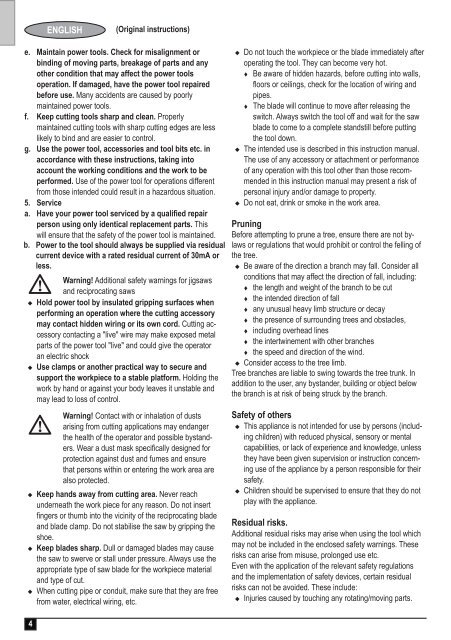BlackandDecker Scie De Decoupe- Rs890 - Type 1 - Instruction Manual (Australie Nouvelle-Zélande)
BlackandDecker Scie De Decoupe- Rs890 - Type 1 - Instruction Manual (Australie Nouvelle-Zélande)
BlackandDecker Scie De Decoupe- Rs890 - Type 1 - Instruction Manual (Australie Nouvelle-Zélande)
Create successful ePaper yourself
Turn your PDF publications into a flip-book with our unique Google optimized e-Paper software.
ENGLISH<br />
Do not touch the workpiece or the blade immediately after<br />
operating the tool. They can become very hot.<br />
Be aware of hidden hazards, before cutting into walls,<br />
Many accidents are caused by poorly<br />
maintained power tools.<br />
Properly<br />
maintained cutting tools with sharp cutting edges are less<br />
likely to bind and are easier to control.<br />
Use of the power tool for operations different<br />
from those intended could result in a hazardous situation.<br />
pipes.<br />
The blade will continue to move after releasing the<br />
switch. Always switch the tool off and wait for the saw<br />
blade to come to a complete standstill before putting<br />
the tool down.<br />
The intended use is described in this instruction manual.<br />
The use of any accessory or attachment or performance<br />
of any operation with this tool other than those recommended<br />
in this instruction manual may present a risk of<br />
personal injury and/or damage to property.<br />
Do not eat, drink or smoke in the work area.<br />
This<br />
will ensure that the safety of the power tool is maintained.<br />
b. Power to the tool should always be supplied via residual<br />
current device with a rated residual current of 30mA or<br />
less.<br />
Additional safety warnings for jigsaws<br />
and reciprocating saws<br />
@<br />
<br />
<br />
Cutting accessory<br />
contacting a "live" wire may make exposed metal<br />
parts of the power tool "live" and could give the operator<br />
an electric shock<br />
Holding the<br />
work by hand or against your body leaves it unstable and<br />
may lead to loss of control.<br />
@<br />
<br />
Contact with or inhalation of dusts<br />
arising from cutting applications may endanger<br />
the health of the operator and possible bystandprotection<br />
against dust and fumes and ensure<br />
that persons within or entering the work area are<br />
also protected.<br />
Never reach<br />
underneath the work piece for any reason. Do not insert<br />
Before attempting to prune a tree, ensure there are not bylaws<br />
or regulations that would prohibit or control the felling of<br />
the tree.<br />
Be aware of the direction a branch may fall. Consider all<br />
conditions that may affect the direction of fall, including:<br />
the length and weight of the branch to be cut<br />
the intended direction of fall<br />
any unusual heavy limb structure or decay<br />
the presence of surrounding trees and obstacles,<br />
including overhead lines<br />
the intertwinement with other branches<br />
the speed and direction of the wind.<br />
Consider access to the tree limb.<br />
Tree branches are liable to swing towards the tree trunk. In<br />
addition to the user, any bystander, building or object below<br />
the branch is at risk of being struck by the branch.<br />
This appliance is not intended for use by persons (including<br />
children) with reduced physical, sensory or mental<br />
capabilities, or lack of experience and knowledge, unless<br />
they have been given supervision or instruction concerning<br />
use of the appliance by a person responsible for their<br />
safety.<br />
Children should be supervised to ensure that they do not<br />
play with the appliance.<br />
and blade clamp. Do not stabilise the saw by gripping the<br />
shoe.<br />
<br />
Dull or damaged blades may cause<br />
the saw to swerve or stall under pressure. Always use the<br />
appropriate type of saw blade for the workpiece material<br />
and type of cut.<br />
When cutting pipe or conduit, make sure that they are free<br />
from water, electrical wiring, etc.<br />
Additional residual risks may arise when using the tool which<br />
may not be included in the enclosed safety warnings. These<br />
risks can arise from misuse, prolonged use etc.<br />
Even with the application of the relevant safety regulations<br />
and the implementation of safety devices, certain residual<br />
risks can not be avoided. These include:<br />
Injuries caused by touching any rotating/moving parts.
















